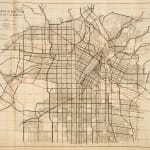Frederick Law Olmstead; Harland Bartholomew; Charles Henry Cheney
Major Traffic Street Plan, Los Angeles, California, 1924
Lithograph on paper
23 x 29 1/2 inches (map); 4 x 6 inches (booklet)
Paper covers.
Paper covers.
Sold
Further images
This map represents the first major civic undertaking to address one of Los Angeles’s most defining and frustrating aspects - the traffic. The result of a two-year study, the map...
This map represents the first major civic undertaking to address one of Los Angeles’s most defining and frustrating aspects - the traffic.
The result of a two-year study, the map was compiled by famed landscape architect Frederick Law Olmstead, along with transportation planner Harland Bartholow and urban planner Charles H. Cheney. The men sought to address LA’s increasingly escalating traffic issues, which were due to the city’s population boom in the early 20th-century as well as the automobile’s rapid rise in popularity. The solution, in their words, was to create “a comprehensive plan for the reconstruction of the ill-arranged collection of streets of Los Angeles into a well ordered system of traffic arteries.”
The proposal argued for adjustments such as a separation of traffic classes so through traffic would not mix with local traffic and street cars, underpasses and viaducts at busy intersections to separate traffic moving in different directions, and elevated highways to separate automobiles from streetcars.
As well, a key element of the proposal, visualized by the map, was “a system of broad streets and boulevards from 80 to 100 feet wide leading through and from the city in all directions; easily accessible from the minor streets and avenues.” For example, one proposal (which never came to fruition) was for the Downtown portion of First Street to be widened to 150 feet, and then extended northwest up to Hollywood - roughly what would end up as the Hollywood Freeway a generation later. On the verso of the map there is a detailed, street-by-street description of proposal.
Many of the committee’s newly-proposed roads and suggested adjustments to existing ones never made it past the idea stage. One interesting, unrealized concept was the creation of a “River Truck Speedway,” a commercial vehicle-only road running from San Fernando Valley to the harbor, somewhat adjacent to the Los Angeles River. Other proposed roads shown on the map that never came to be include “the Hollywood-Palos Verdes Parkway” and “the Silver Lake Parkway.”
There was an aesthetic aim to the project as well. They wrote that, “its adoption and execution will make beautiful Los Angeles still more beautiful, as well as a more comfortable place in which to live and move and have one's being.”
Though only a small portion of these proposals were actually realized, the results of this groundbreaking analysis are still apparent on Los Angeles roads today. For example, the seemingly-baffling fact that downtown's large thoroughfares are all one-way only streets is due to this study.
The result of a two-year study, the map was compiled by famed landscape architect Frederick Law Olmstead, along with transportation planner Harland Bartholow and urban planner Charles H. Cheney. The men sought to address LA’s increasingly escalating traffic issues, which were due to the city’s population boom in the early 20th-century as well as the automobile’s rapid rise in popularity. The solution, in their words, was to create “a comprehensive plan for the reconstruction of the ill-arranged collection of streets of Los Angeles into a well ordered system of traffic arteries.”
The proposal argued for adjustments such as a separation of traffic classes so through traffic would not mix with local traffic and street cars, underpasses and viaducts at busy intersections to separate traffic moving in different directions, and elevated highways to separate automobiles from streetcars.
As well, a key element of the proposal, visualized by the map, was “a system of broad streets and boulevards from 80 to 100 feet wide leading through and from the city in all directions; easily accessible from the minor streets and avenues.” For example, one proposal (which never came to fruition) was for the Downtown portion of First Street to be widened to 150 feet, and then extended northwest up to Hollywood - roughly what would end up as the Hollywood Freeway a generation later. On the verso of the map there is a detailed, street-by-street description of proposal.
Many of the committee’s newly-proposed roads and suggested adjustments to existing ones never made it past the idea stage. One interesting, unrealized concept was the creation of a “River Truck Speedway,” a commercial vehicle-only road running from San Fernando Valley to the harbor, somewhat adjacent to the Los Angeles River. Other proposed roads shown on the map that never came to be include “the Hollywood-Palos Verdes Parkway” and “the Silver Lake Parkway.”
There was an aesthetic aim to the project as well. They wrote that, “its adoption and execution will make beautiful Los Angeles still more beautiful, as well as a more comfortable place in which to live and move and have one's being.”
Though only a small portion of these proposals were actually realized, the results of this groundbreaking analysis are still apparent on Los Angeles roads today. For example, the seemingly-baffling fact that downtown's large thoroughfares are all one-way only streets is due to this study.





